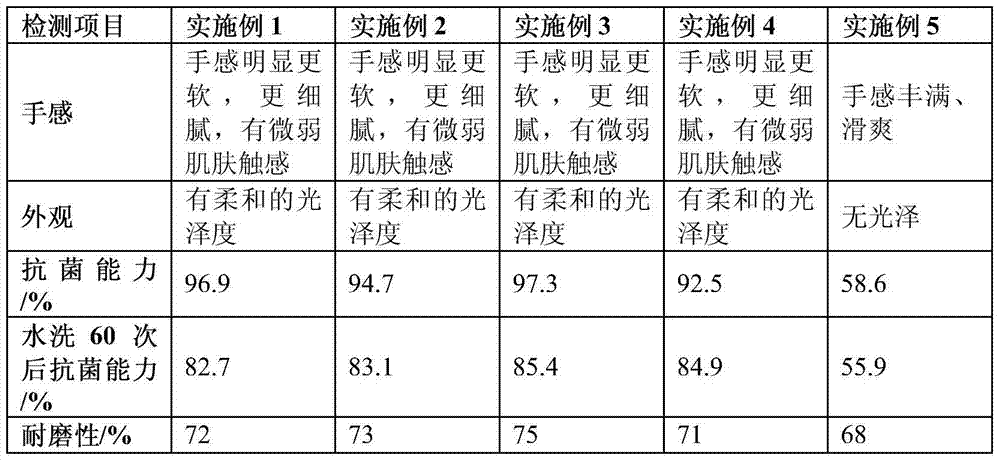A new type of antibacterial imitation jeanette fabric
A technique for imitating jeanette and fabrics, which is applied in biochemical fiber treatment, textiles and papermaking, fiber treatment, etc. It can solve the problems of high price and insufficient antibacterial properties of fabrics, and achieves improved softness, good antibacterial performance, and good hand feeling Effect
- Summary
- Abstract
- Description
- Claims
- Application Information
AI Technical Summary
Problems solved by technology
Method used
Image
Examples
Embodiment 1
[0021] A preparation method of a novel antibacterial imitation jeanette fabric, the steps are as follows:
[0022] (1) The blending ratio of soybean fiber and cotton fiber is 3:7 for blending according to the weight percentage; conventional singeing, whitening and drying are carried out to the blended fabric;
[0023] Wherein the concentration of the caustic soda that adopts during singeing is 90g / L,
[0024] (2) Grinding: use metal abrasive grains for dry grinding;
[0025] (3) Microbial modification treatment:
[0026] Bacillus licheniformis, Sphingomonas, Lactococcus lactis, and Bifidobacterium are formulated into a composite bacterial agent according to the quantitative ratio of 1:0.2:1.5:0.2;
[0027] The brushed fabric is evenly sprayed with bacteria agent, and fermented at 38°C for 52 hours;
[0028] After fermentation, wash with warm water and dry;
[0029] (5) Polishing treatment: polishing the modified fabric;
[0030] (6) Dyeing according to conventional method...
Embodiment 2
[0032] A preparation method of a novel antibacterial imitation jeanette fabric, the steps are as follows:
[0033] (1) The blending ratio of soybean fiber and cotton fiber is 3:7 for blending according to the weight percentage; conventional singeing, whitening and drying are carried out to the blended fabric;
[0034] Wherein the concentration of the caustic soda that adopts during singeing is 105g / L,
[0035] (2) Grinding: use metal abrasive grains for dry grinding;
[0036] (3) Microbial modification treatment:
[0037] Bacillus licheniformis, Sphingomonas, Lactococcus lactis, and Bifidobacterium are formulated into a composite bacterial agent according to the quantitative ratio of 1:0.2:1.5:0.1;
[0038] The brushed fabric is evenly sprayed with bacteria agent and fermented at 38°C for 65 hours;
[0039] After fermentation, wash with warm water and dry;
[0040] (5) Polishing treatment: polishing the modified fabric;
[0041] (6) Dyeing according to conventional method...
Embodiment 3
[0043] A preparation method of a novel antibacterial imitation jeanette fabric, the steps are as follows:
[0044] (1) The blending ratio of soybean fiber and cotton fiber is 3:7 for blending according to the weight percentage; conventional singeing, whitening and drying are carried out to the blended fabric;
[0045] Wherein the concentration of the caustic soda that adopts during singeing is 100g / L,
[0046] (2) Grinding: use metal abrasive grains for dry grinding;
[0047] (3) Microbial modification treatment:
[0048] Bacillus licheniformis, Sphingomonas, Lactococcus lactis, and Bifidobacterium are formulated into a composite bacterial agent according to the quantitative ratio of 1:0.2:1.5:0.2;
[0049] The brushed fabric is evenly sprayed with bacteria agent and fermented at 38°C for 60 hours;
[0050] After fermentation, wash with warm water and dry;
[0051] (5) Polishing treatment: polishing the modified fabric;
[0052] (6) Dyeing according to conventional method...
PUM
 Login to View More
Login to View More Abstract
Description
Claims
Application Information
 Login to View More
Login to View More - R&D
- Intellectual Property
- Life Sciences
- Materials
- Tech Scout
- Unparalleled Data Quality
- Higher Quality Content
- 60% Fewer Hallucinations
Browse by: Latest US Patents, China's latest patents, Technical Efficacy Thesaurus, Application Domain, Technology Topic, Popular Technical Reports.
© 2025 PatSnap. All rights reserved.Legal|Privacy policy|Modern Slavery Act Transparency Statement|Sitemap|About US| Contact US: help@patsnap.com

